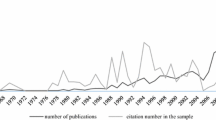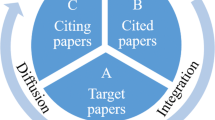Abstract
Research competitiveness analysis refers to the measurement, comparison and analysis of the research status (i.e., strength and/or weakness) of different scientific research bodies (e.g., institutions, researchers, etc.) in different research fields. Improving research competitiveness analysis method can be conducive to accurately obtaining the research status of research fields and research bodies. This paper presents a method of evaluating the competitiveness of research institutions based on research topic distribution. The method uses the LDA topic model to obtain a paper-topic distribution matrix to objectively assign the academic impact of papers (such as number of citations) to research topics. Then the method calculates the competitiveness of each research institution on each research topic with the help of an institution-paper matrix. Finally, the competitiveness and the research strength and/or weakness of the institutions are defined and characterized. A case study shows that the method can lead to an objective and effective evaluation of the research competitiveness of research institutions in a given research field.





Similar content being viewed by others
Notes
Data retrieval time: Jan. 2017.
Actually, in our case study, except documents, we only give a topic number (i.e., 5) to the algorithm to get the result topic distributions.
References
Aggarwal, C. C., & Zhai, C. X. (2012). Mining text data. Boston, MA: Springer.
Blei, D. M., Ng, A. Y., & Jordan, M. I. (2003). Latent Dirichlet allocation. Journal of Machine Learning Research, 3, 993–1022.
Chen, C. (2006). CiteSpace II: Detecting and visualizing emerging trends and transient patterns in scientific literature. Journal of the American Society for Information Science and Technology, 57(3), 359–377.
Chen, C., Hu, Z., Liu, S., & Hung, T. (2012). Emerging trends in regenerative medicine: A scientometric analysis in CiteSpace. Expert Opinion on Biological Therapy, 12(5), 593–608.
Chen, S., Shi, L., & Zuo, W. (2013). Theoretical and empirical study on measure method of academic influence indicator based on ESI. Library and Information Service, 57(2), 97–102. (in Chinese).
Cova, T. F., Alberto, A. P., & Sebastião, J. F. (2013). Iberian universities: A characterization from ESI rankings. Scientometrics, 94(3), 1239–1251.
Dong, Z., & Chen, H. (2014). Investigation into library service model of university discipline evaluation on the basis of ESI and InCites databases. Library Journal, 33(11), 23–28.
Faust, O. (2018). Documenting and predicting topic changes in computers in biology and medicine: A bibliometric keyword analysis from 1990 to 2017. Informatics in Medicine Unlocked, 11, 15–27.
Gao, S., Li, X., Yu, Z., Qin, Y., & Zhang, Y. (2017). Combining paper cooperative network and topic model for expert topic analysis and extraction. Neurocomputing, 257, 136–143.
Gei, F., & Tan, Z. (2013). Emerging trend detection methods of the subject discipline area themes. Information Studies: Theory & Application, 36(9), 78–82.
Li, M., Zhang, Z., Chen, S., & Zuo, W. (2012). An ESI based analysis of the competitiveness in plant & animal sciences of China Agricultural University. Science and Technology Management Research, 8, 128–132. (in Chinese).
Liu, J., & Mei, Y. (2015). Research on the subject development forecast based on ESl and lnCites–taking China University of Geosciences as an example. Sci-Tech Information Development & Economy, 6, 056.
Mimno, D., Mccallum, A., & Mann, G. S. (2006). Bibliometric impact measures leveraging topic analysis. In Joint conference on digital library (pp. 65–74).
Mkhnacheva, Y. (2011). Research performance of RAS Institutions and Russian Universities: A comparative bibliometric analysis. Herald of the Russian Academy of Sciences, 81(6), 569–574.
Morris, S. A., Yen, G., & Wu, Z. (2003). Time line visualization of research fronts. Journal of American Society for Information Science, 54(5), 413–422.
Shibata, N., Kaiikawa, Y., & Takdea, Y. (2008). Detecting emerging research fronts based on topological measures in citation networks of scientific publications. Technovation, 282(11), 758–775.
Small, H., Boyack, K. W., & Klavans, R. (2014). Identifying emerging topics in science and technology. Research Policy, 43(8), 1450–1467.
Small, H., & Upham, P. (2009). Citation structure of an emerging research area on the verge of application. Scientometrics, 79(2), 365–375.
Suominen, A., & Toivanen, H. (2016). Map of science with topic modeling: Comparison of unsupervised learning and human-assigned subject classification. Journal of the Association for Information Science and Technology, 67(10), 2464–2476.
Yau, C. K., Porter, A., Newman, N., & Suominen, A. (2014). Clustering scientific documents with topic modeling. Scientometrics, 100(3), 767–786.
Yue, M. L., & Ma, T. C. (2017). Topic based research competitiveness evaluation. In Proceedings of ISSI 2017—The 16th international conference on scientometrics and informetrics (pp. 1240–1246). China: Wuhan University.
Zhang, F., Tan, Z., & Wang, Y. (2014). Measurement of the research topics of research institutions: A case study on information science of China. Library and Information Service, 58(8), 85–90. (in Chinese).
Zhang, Y., Zhang, G., Chen, H., Porter, A. L., Zhu, D., & Lu, J. (2016). Topic analysis and forecasting for science, technology and innovation: Methodology with a case study focusing on big data research. Technological Forecasting and Social Change, 105, 179–191.
Acknowledgements
The present study is an extended version of an article (Yue and Ma 2017) presented at the 16th International Conference on Scientometrics and Informetrics, Wuhan (China), 16–20 October 2017. This work is supported by the National Natural Science Foundation of China under Grant (No. 71603252); the Young Talent-Field Frontier Project of Wuhan Documentation and Information Center, Chinese Academy of Sciences.
Author information
Authors and Affiliations
Corresponding author
Rights and permissions
About this article
Cite this article
Ma, T., Li, R., Ou, G. et al. Topic based research competitiveness evaluation. Scientometrics 117, 789–803 (2018). https://doi.org/10.1007/s11192-018-2891-7
Received:
Published:
Issue Date:
DOI: https://doi.org/10.1007/s11192-018-2891-7




